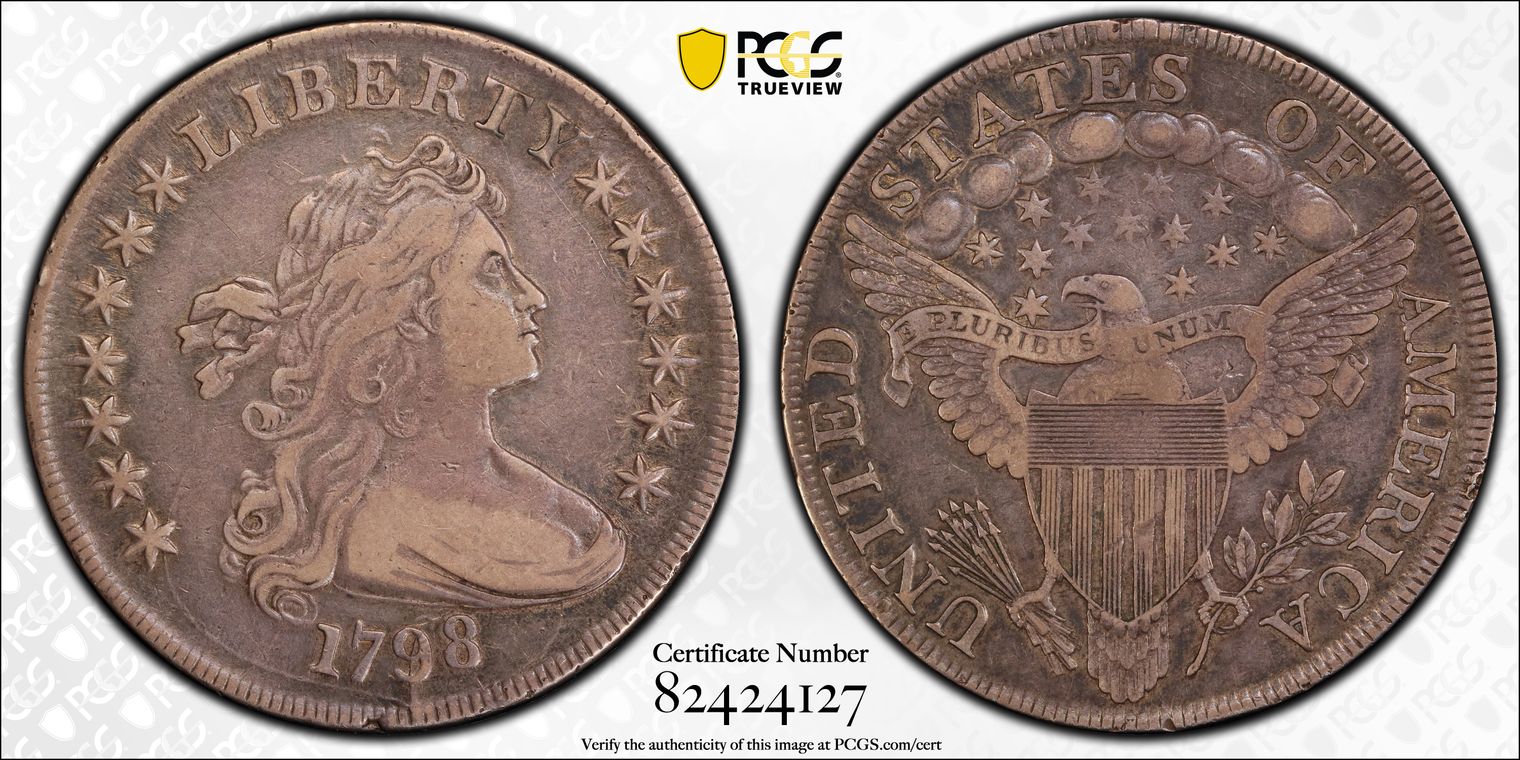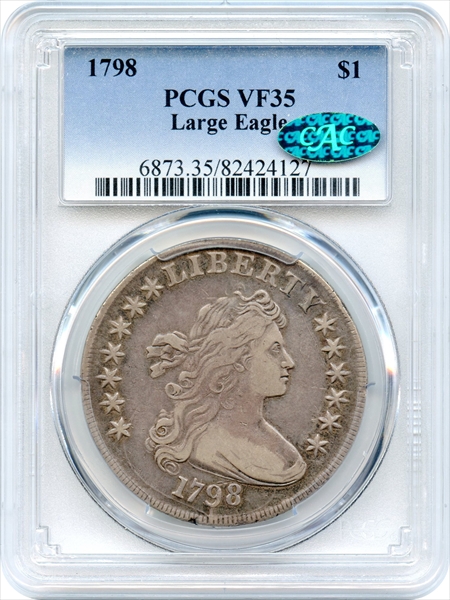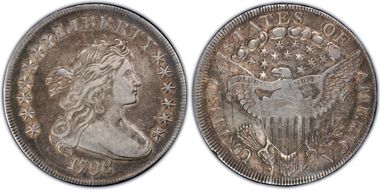1798 $1 BB-118 VF35 认证号82424127, PCGS号40035
拥有者评论
CAC. B-28, BB-118
专家评论
Q. David Bowers
The following narrative, with minor editing, is from my "Silver Dollars & Trade Dollars of the United States: A Complete Encyclopedia" (Wolfeboro, NH: Bowers and Merena Galleries, Inc., 1993). Note: the Notable Specimens list should be used with caution - it has been updated in my 2013 edition of "The Encyclopedia of United States Silver Dollars 1794-1804."B-28, H-28.
OBVERSE 13: See description under 1798 BB-113. Obverse die used to strike BB-113 (1st use), 1798 BB-114 (2nd uses), BB-115 (3rd use), BB-116 (4th use), BB-117 (5th use), BB-118 (6th use),BB-119 (7th and final use).
REVERSE P: Leaf point is slightly right of center of 1 in AMERICA. Tip of branch points to tip of rightmost tail feather (compare to reverse shared by BB-92 and BB-91, and to the reverse of BB-117, the only other 1798 reverses in which this is the. case). Star distant from eagle's beak; star ray points to just left of B in PLURIBUS. Arc star pattern. 13 perfect arrows. Five medium-sized berries, the two at top closest together. A die crack begins at border above last S in STATES, and passes through center of OF, right wing, bottom of AME, up through RIC. Short crack from last A to border, another from lower outside leaf of branch past claw to stem end. Heavy crack from lower left part of shield down through claw and arrow butts. Another die crack through U and left wing. Another crack through NITE up through TA. The left upright of N is clearly punched over a previous erroneous I. (This characteristic discovered by Thomas K. DeLorey, October 2, 1992.)
Reverse die used to strike 1798 BB-118 only.
DIE STATES: (Robert M. Stark's article, "Die Deterioration of a 1798 Dollar (Bolender-28 Reverse)," in the John Reich Journal, August 1992, was used in the compilation of this information. However, Dr. Stark designates the first state, with no defects, as B-28a. I follow a different numbering sequence.)
Die State I: Obverse with cracks slightly advanced from those on BB-117. Reverse die perfect. Not listed by Bolender; Stark Bolender-28a. Scarce. Auction appearances, which may include duplication, include DeCoppet (1955) VF-35, Ostheimer (1968) VF-EF, Spies (1974) VF, and 1975 ANA VF-30 dull.
Die State II: Obverse: As preceding. Reverse: Two reverse die cracks, approximately parallel, immediately to the left of the eagle's tail. Stark Bolender-28b.
Die State III: Intermediate stage(s) between II and IV; not detailed by Dr. Stark, but probably made.
Die State IV: As II, but with additional cracks from rim through U to N to arrow to second feather; rim over U through NITE to wing to STA; 0 through F to AMERIC to rim; rim below stem to nearest A; stem to claw to leaf. Small piece of die missing in area of two approximately parallel cracks immediately to the left of the eagle's-tail, The approximate die state described by Bolender for Bolender-28; Stark Bolender-28c.
Die State V: As IV, but now with larger piece of die missing to left of eagle's tail. Stark Bolender-28d. The Spies Collection coin (Stack's, 1974), F-12, damaged, had the reverse off center, indicating axial misalignment of dies; this coin may have been of this approximate die state.
Die State VI: As V, but now with entire section of die missing from area earlier within two approximately parallel cracks to the left of the eagle's tail. Crack from tip of center arrow to the 4th feather. An earlier crack, first seen on Die State II, and extending to the ribbon there, has now crossed the ribbon at P, passing through the leftmost star and extending to the 2nd cloud from the left. By this time, on the obverse clash marks are visible between the bust and the final three stars on the right. Stark Bolender-28e.
COLLECTING NOTES: The 1798 BB-118 is of medium rarity among die varieties of the year. I estimate that 275 to 450 exist. Most of these are in lower grades through VF, although EF pieces are occasionally seen. AU or finer coins are rare.
NOTABLE SPECIMENS:
Boyd Specimen. MS-60. Numismatic Gallery, World's Greatest Collection, F.C.C. Boyd, 1945: 54. "A very choice piece, in Uncirculated condition."
Hollinbeck-Kagin Specimen. MS-60. August 1970: 1082. "Uncirculated golden with just the barest trace of rubbing to mar its beauty, several interesting die breaks causing center portion of reverse not to be fully struck up."
French Specimen. MS-60. Stack's, French Family Collection, 1989: 547. "Brilliant Uncirculated, full mint lustre. A trifle weak in the very centers. The obverse breaks are present as are the reverse breaks except for the one from NITE up through TA. Delicate golden russet toning."
Stack Specimen. MS-60. Stack's, James A. Stack Collection, 1989:527. "Brilliant Uncirculated, typical softness above the eagle's head. Gray tan laced with silver on the obverse; the reverse deeper gray violet. Die breaks well advanced. The reverse is a bit off center, with broad denticles at the left."
Fairbanks Specimen. AU-55. Stack's, Fairbanks Collection, 1960:550. "The early strike before the reverse die cracked, as described by Bolender. Softly struck, just a shade from Uncirculated, full mint frost."
Spies Specimen. AU-50. Stack's, W. Earl Spies Collection, 1974:103. "Reverse with most of the breaks mentioned by Bolender. Struck slightly off center, but really a beautiful specimen. AU, with considerable lustre. Light golden and iridescent toning."
Willasch Specimen. AU-50. Superior Galleries, H. Roland Willasch Collection, 1990:509. "Lovely mottled color throughout, the centers glowing yellow, the periphery ranging from light green to blue. The central reverse has all detail visible, although not sharp. Lustre still resides in the fields. Dies are both cracked, obverse with the familiar crack through and below the date, the reverse from the shield, arrow butts to the rim with another heavy crack through the U of UNITED, wing to clouds above eagle."
Auction '90 Specimen. AU-50. Stack's, 1990:255. "AU, full hair detail. Deep gray and silver with touches of red. Good detail on the devices. Well developed die breaks."
March 1991 Sale Specimen. AU-50. Stack's, 1991:1633. "Rich gold and lighter russet toning. All die breaks clear." • Yolanda Gross Collection.
PCGS #
40035
设计师
Robert Scot
边缘
Lettered: HUNDRED CENTS ONE DOLLAR OR UNIT
直径
40.00 毫米
重量
27.00 克
铸币数量
287536
金属成分
90% Silver, 10% Copper
更高评级数量
9
评级较低的钱币数量
8
地区
The United States of America
价格指南
PCGS 数量报告
拍卖 - PCGS 评级的
拍卖 - NGC 评级的



























